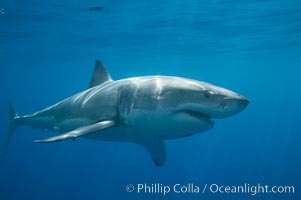
A great white shark swims toward the photographer. Perhaps the shark is considering him as possible prey? The photographer, a "shark diver" is safely situated in a sturdy metal cage. The best location in the world to "shark dive" to view great white sharks is Mexico's Guadalupe Island.
Species: Great white shark, Carcharodon carcharias
Location: Guadalupe Island (Isla Guadalupe), Baja California, Mexico
Image ID: 19480
Species: Great white shark, Carcharodon carcharias
Location: Guadalupe Island (Isla Guadalupe), Baja California, Mexico
Image ID: 19480
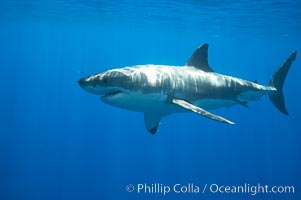
A great white shark is countershaded, with a dark gray dorsal color and light gray to white underside, making it more difficult for the shark's prey to see it as approaches from above or below in the water column. The particular undulations of the countershading line along its side, where gray meets white, is unique to each shark and helps researchers to identify individual sharks in capture-recapture studies. Guadalupe Island is host to a relatively large population of great white sharks who, through a history of video and photographs showing their countershading lines, are the subject of an ongoing study of shark behaviour, migration and population size.
Species: Great white shark, Carcharodon carcharias
Location: Guadalupe Island (Isla Guadalupe), Baja California, Mexico
Image ID: 19481
Species: Great white shark, Carcharodon carcharias
Location: Guadalupe Island (Isla Guadalupe), Baja California, Mexico
Image ID: 19481

Guadalupe Island at sunrise, panorama. Volcanic coastline south of Pilot Rock and Spanish Cove, near El Faro lighthouse.
Location: Guadalupe Island (Isla Guadalupe), Baja California, Mexico
Image ID: 19497
Panorama dimensions: 2797 x 16157
Location: Guadalupe Island (Isla Guadalupe), Baja California, Mexico
Image ID: 19497
Panorama dimensions: 2797 x 16157
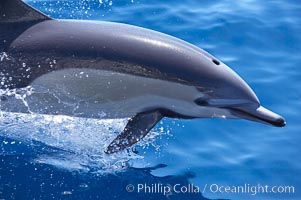
Common dolphin leaping.
Species: Common dolphin, Delphinus delphis
Location: Guadalupe Island (Isla Guadalupe), Baja California, Mexico
Image ID: 19485
Species: Common dolphin, Delphinus delphis
Location: Guadalupe Island (Isla Guadalupe), Baja California, Mexico
Image ID: 19485
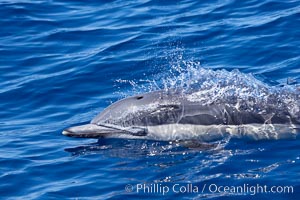
Common dolphin leaping.
Species: Common dolphin, Delphinus delphis
Location: Guadalupe Island (Isla Guadalupe), Baja California, Mexico
Image ID: 19486
Species: Common dolphin, Delphinus delphis
Location: Guadalupe Island (Isla Guadalupe), Baja California, Mexico
Image ID: 19486
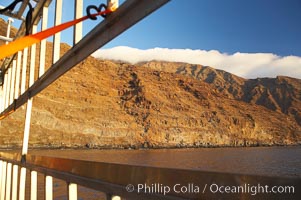
Guadalupe island at sunrise, viewed through the bars of an aluminum shark cage.
Location: Guadalupe Island (Isla Guadalupe), Baja California, Mexico
Image ID: 19487
Location: Guadalupe Island (Isla Guadalupe), Baja California, Mexico
Image ID: 19487
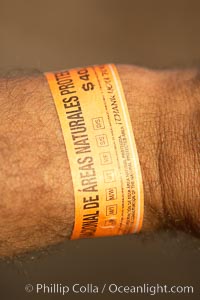
Permit wristband issued by Mexican environmental agencies to shark divers to support research, conservation and protection of Isla Guadalupe Special Biosphere Reserve.
Location: Guadalupe Island (Isla Guadalupe), Baja California, Mexico
Image ID: 19488
Location: Guadalupe Island (Isla Guadalupe), Baja California, Mexico
Image ID: 19488
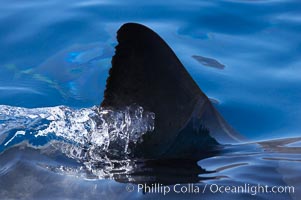
Dorsal fin of a great white shark breaks the surface as the shark swims just below.
Species: Great white shark, Carcharodon carcharias
Location: Guadalupe Island (Isla Guadalupe), Baja California, Mexico
Image ID: 19489
Species: Great white shark, Carcharodon carcharias
Location: Guadalupe Island (Isla Guadalupe), Baja California, Mexico
Image ID: 19489
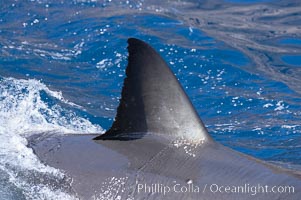
Dorsal fin of a great white shark breaks the surface as the shark swims just below.
Species: Great white shark, Carcharodon carcharias
Location: Guadalupe Island (Isla Guadalupe), Baja California, Mexico
Image ID: 19491
Species: Great white shark, Carcharodon carcharias
Location: Guadalupe Island (Isla Guadalupe), Baja California, Mexico
Image ID: 19491
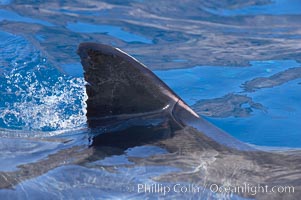
Dorsal fin of a great white shark breaks the surface as the shark swims just below.
Species: Great white shark, Carcharodon carcharias
Location: Guadalupe Island (Isla Guadalupe), Baja California, Mexico
Image ID: 19492
Species: Great white shark, Carcharodon carcharias
Location: Guadalupe Island (Isla Guadalupe), Baja California, Mexico
Image ID: 19492
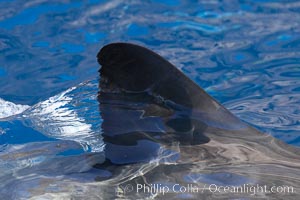
Dorsal fin of a great white shark breaks the surface as the shark swims just below.
Species: Great white shark, Carcharodon carcharias
Location: Guadalupe Island (Isla Guadalupe), Baja California, Mexico
Image ID: 19494
Species: Great white shark, Carcharodon carcharias
Location: Guadalupe Island (Isla Guadalupe), Baja California, Mexico
Image ID: 19494
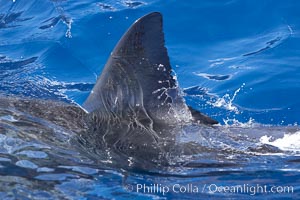
Dorsal fin of a great white shark breaks the surface as the shark swims just below.
Species: Great white shark, Carcharodon carcharias
Location: Guadalupe Island (Isla Guadalupe), Baja California, Mexico
Image ID: 19495
Species: Great white shark, Carcharodon carcharias
Location: Guadalupe Island (Isla Guadalupe), Baja California, Mexico
Image ID: 19495
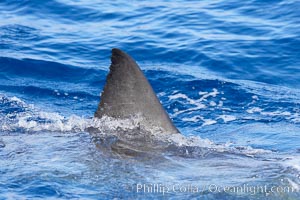
Dorsal fin of a great white shark breaks the surface as the shark swims just below.
Species: Great white shark, Carcharodon carcharias
Location: Guadalupe Island (Isla Guadalupe), Baja California, Mexico
Image ID: 19496
Species: Great white shark, Carcharodon carcharias
Location: Guadalupe Island (Isla Guadalupe), Baja California, Mexico
Image ID: 19496
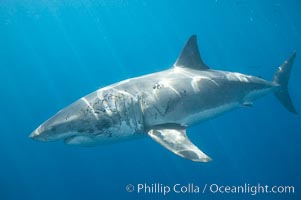
A great white shark shows scarring on the left side of its body, almost certainly the result of bites from another white shark. Certain formidable prey, such as huge elephant seals who have claws and large jaws, can also inflict injuries on the shark during the course of an attack. Such injuries, especially to the eyes or gills, could be fatal to the shark. In this case the shark has survived its injuries and the resulting scars are helping researchers identify this shark.
Species: Great white shark, Carcharodon carcharias
Location: Guadalupe Island (Isla Guadalupe), Baja California, Mexico
Image ID: 19482
Species: Great white shark, Carcharodon carcharias
Location: Guadalupe Island (Isla Guadalupe), Baja California, Mexico
Image ID: 19482
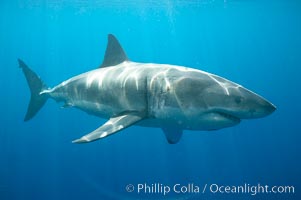
A great white shark swims through the clear waters of Isla Guadalupe, far offshore of the Pacific Coast of Mexico's Baja California. Guadalupe Island is host to a concentration of large great white sharks, which visit the island to feed on pinnipeds and use it as a staging area before journeying farther into the Pacific ocean.
Species: Great white shark, Carcharodon carcharias
Location: Guadalupe Island (Isla Guadalupe), Baja California, Mexico
Image ID: 19483
Species: Great white shark, Carcharodon carcharias
Location: Guadalupe Island (Isla Guadalupe), Baja California, Mexico
Image ID: 19483
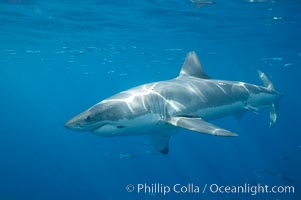
A great white shark is countershaded, with a dark gray dorsal color and light gray to white underside, making it more difficult for the shark's prey to see it as approaches from above or below in the water column. The particular undulations of the countershading line along its side, where gray meets white, is unique to each shark and helps researchers to identify individual sharks in capture-recapture studies. Guadalupe Island is host to a relatively large population of great white sharks who, through a history of video and photographs showing their countershading lines, are the subject of an ongoing study of shark behaviour, migration and population size.
Species: Great white shark, Carcharodon carcharias
Location: Guadalupe Island (Isla Guadalupe), Baja California, Mexico
Image ID: 19484
Species: Great white shark, Carcharodon carcharias
Location: Guadalupe Island (Isla Guadalupe), Baja California, Mexico
Image ID: 19484
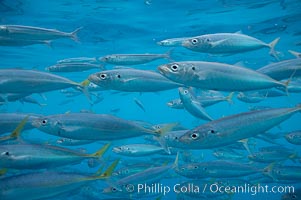
Mackeral, likely chubb mackeral (Scomber japonicus).
Species: Pacific mackerel, Scomber japonicus
Location: Guadalupe Island (Isla Guadalupe), Baja California, Mexico
Image ID: 19498
Species: Pacific mackerel, Scomber japonicus
Location: Guadalupe Island (Isla Guadalupe), Baja California, Mexico
Image ID: 19498
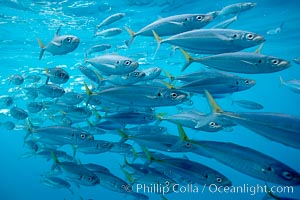
Mackeral, likely chubb mackeral (Scomber japonicus).
Species: Pacific mackerel, Scomber japonicus
Location: Guadalupe Island (Isla Guadalupe), Baja California, Mexico
Image ID: 19499
Species: Pacific mackerel, Scomber japonicus
Location: Guadalupe Island (Isla Guadalupe), Baja California, Mexico
Image ID: 19499
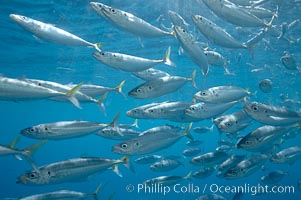
Mackeral, likely chubb mackeral (Scomber japonicus).
Species: Pacific mackerel, Scomber japonicus
Location: Guadalupe Island (Isla Guadalupe), Baja California, Mexico
Image ID: 19500
Species: Pacific mackerel, Scomber japonicus
Location: Guadalupe Island (Isla Guadalupe), Baja California, Mexico
Image ID: 19500
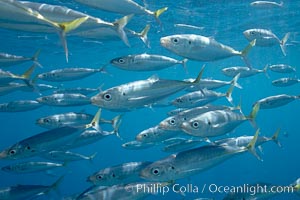
Mackeral, likely chubb mackeral (Scomber japonicus).
Species: Pacific mackerel, Scomber japonicus
Location: Guadalupe Island (Isla Guadalupe), Baja California, Mexico
Image ID: 19501
Species: Pacific mackerel, Scomber japonicus
Location: Guadalupe Island (Isla Guadalupe), Baja California, Mexico
Image ID: 19501